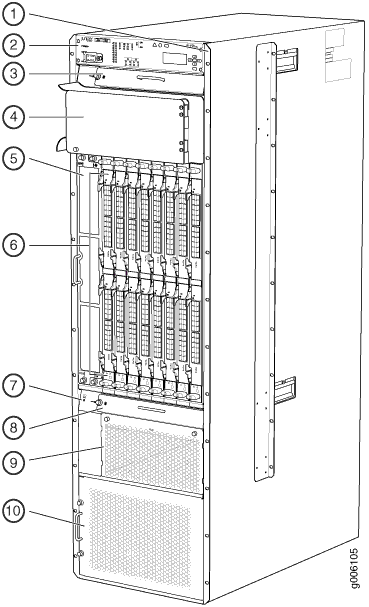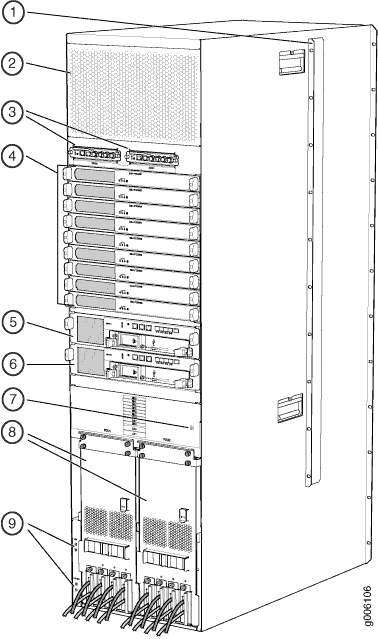PTX5000 System Overview
PTX5000 Description
The Juniper Networks PTX5000 Packet Transport Router is designed for large networks and network applications, such as those supported by ISPs and high-volume content providers.
Benefits of the PTX5000 Router
Increased scalability—The PTX5000 scales to 24 Tbps in a single chassis, supporting up to 1536 10-Gigabit Ethernet interfaces, 384 40-Gigabit Ethernet interfaces, and 240 100-Gigabit Ethernet interfaces, giving service providers the performance and scalability needed as networks grow. The purpose-built ASICs in the PTX5000 provide enhanced packet processing for both full IP functionality and MPLS transport, accommodating scale as traffic continues to increase and optimizing IP/MPLS transit functionality.
Always-on infrastructure base—The PTX5000 is engineered with full hardware redundancy for cooling, power, Routing Engines, Control Boards, and Switch Interface Boards (SIBs), allowing service providers to meet stringent service-level agreements across the core.
Nondisruptive software upgrades—The PTX5000 features a resilient operating system that supports high availability (HA) features such as graceful Routing Engine switchover (GRES), nonstop active routing (NSR), and unified in-service software upgrade (unified ISSU), providing software upgrades and changes without disrupting network traffic.
System Overview
The PTX5000 occupies 36 rack units (36 U) and accommodates up to eight Flexible PIC Concentrators (FPCs), each of which can be configured with two Physical Interface Cards (PICs) to support a variety of network media types.
The system architecture of the PTX5000 cleanly separates control operations from packet forwarding operations. This design eliminates processing and traffic bottlenecks, permitting the PTX5000 to achieve high performance.
Control operations are performed by the host subsystem, which runs the Junos operating system (Junos OS) to handle routing protocols, traffic engineering, policy, policing, monitoring, and configuration management.
Forwarding operations are performed by the Packet Forwarding Engines, which consist of hardware, including ASICs, designed by Juniper Networks. The ASICs are a definitive part of the hardware design and enable the PTX5000 to achieve data forwarding rates that match current fiber-optic capacity. For the forwarding capacity of each supported FPC type, see FPCs Supported on the PTX5000.
Figure 1 and Figure 2 illustrate the front and rear of a PTX5000 and its components.

1 — Front-mounting flange | 6 — FPCs and PICs |
2 — Craft interface | 7 — ESD point |
3 — Upper horizontal fan tray | 8 — Lower horizontal fan tray |
4 — Cable management system | 9 — Horizontal air filter |
5 — Vertical fan tray and vertical air filter | 10 — Power supply module door and power supply modules air filter |

1 — Center-mounting bracket | 6 — Control Board CB1 and Routing Engine RE1 |
2 — Air exhaust | 7 — ESD point |
3 — Centralized Clock Generators (CCGs) | 8 — Power distribution units (PDUs) |
4 — Switch Interface Boards (SIBs) | 9 — Chassis grounding points |
5 — Control Board CB0 and Routing Engine RE0 |
See Also
PTX5000 System Architecture Description
The PTX5000 has two main architectural components:
Routing Engine—One or more Routing Engines provide Layer 3 routing services and network management.
Packet Forwarding Engines—These high-performance, ASIC-based components provide packet forwarding, route lookups, and Layer 2 and Layer 3 packet switching. See PTX5000 Packet Forwarding Engine Architecture for more information.
The Routing Engines and the Packet Forwarding Engines perform their primary tasks independently, but communicate through multiple links. This arrangement streamlines forwarding and routing control and runs Internet-scale backbone networks at high speeds.
PTX5000 Packet Forwarding Engine Architecture
The Packet Forwarding Engines provide Layer 2 and Layer 3 packet switching, forwarding, and route lookup functions.
The Packet Forwarding Engines are implemented in ASICs that are physically located on the FPCs. Each Packet Forwarding Engine consists of the following components:
Lookup ASICs, which provide the route lookup function, control functions, Layer 2 and Layer 3 encapsulation and de-encapsulation, and manage the division and reassembly of packets within the PTX5000.
Queuing and Memory Interface ASICs, which manage the buffering of data cells in memory and the queueing of notifications.
The fabric ASICs, located on the Switch Interface Boards (SIBs), extract the route lookup key and manage the flow of data cells across the switch fabric.
PTX5000 Hardware Component Overview
The PTX5000 supports the components in Table 1 listed in alphabetic order.
The en dash (–) means that the item is not applicable.
Component |
Model Number |
Hardware Label |
CLI Output |
Description |
|---|---|---|---|---|
Cable management system |
– |
– |
– |
|
Centralized Clock Generator (CCG) |
CCG-PTX |
CCG |
|
|
CCG-BLANK-PTX |
– |
– |
– |
– |
Chassis |
– |
– |
|
|
Vertical fan tray |
FAN-PTX-V |
FANTRAY PTX VERTICAL |
|
|
Horizontal fan tray |
FAN-PTX-H |
FANTRAY PTX HORIZONTAL |
|
|
FAN3-PTX-H |
FANTRAY PTX 2 HORIZONTAL |
|
||
Air filter kit including the horizontal air filter, vertical air filter, and PSM air filter Note:
The air filter kit is available for replacements required for maintenance. See Maintaining the PTX5000 Air Filters |
FLTR-PTX-KIT |
– |
– |
– |
Control Board |
CB-PTX |
CB-PTX |
|
|
CB2-PTX |
CB2-PTX |
|
||
CB-BLANK |
– |
– |
– |
– |
Craft interface |
CRAFT-PTX5000 |
JUNIPER NETWORKS PTX5000 |
|
|
FPC |
FPC-PTX-P1-A |
FPC-PTX-P1-A |
|
|
FPC2-PTX-P1A |
FPC2-PTX-P1A |
|
||
FPC3-PTX-U2 |
FPC3-PTX-U2 |
|
||
FPC3-PTX-U3 |
FPC3-PTX-U3 |
|
||
FPC-BLANK |
– |
– |
– |
– |
Host subsystem including Control Board and Routing Engine Note:
CB2-PTX is not supported with RE-DUO-C2600-16G. |
CB-PTX |
CB-PTX |
|
|
CB2-PTX |
CB2-PTX |
|
||
RE-DUO-C2600-16G |
– |
|
||
RE-PTX-X8-64G |
RE-PTX-X8-64G |
|
||
Midplane |
– |
– |
|
|
|
||||
PIC |
See the PTX Series Interface Module Reference for information about the PICs supported on the PTX5000. |
|||
PIC-BLANK-PTX |
– |
– |
– |
– |
Three-phase AC delta PDU |
PDU-PTX-AC-D |
– |
|
|
Three-phase AC wye PDU |
PDU-PTX-AC-W |
– |
|
|
Three-phase AC PSM |
PSM-PTX-AC |
– |
|
|
120-A DC PDU |
PDU-PTX-DC-120 |
– |
|
|
60-A DC PDU |
PDU-PTX-DC-60 |
– |
|
|
High Capacity DC PDU |
PDU2-PTX-DC |
– |
|
|
120-A DC PSM |
PSM-PTX-DC-120 |
– |
|
|
60-A DC PSM |
PSM-PTX-DC-60 |
– |
|
|
High Capacity DC PSM |
PSM2-PTX-DC |
– |
|
|
PSM blank |
PSM-BLANK-PTX |
– |
– |
– |
High Capacity Single-Phase AC PDU |
PDU2-PTX-AC-SP |
PDU2-PTX-AC-SP |
|
|
Metal sleeves and overlay kit for the chassis to upgrade PSM to High Capacity PSMs |
PTX5K-PSM2TRAY |
– |
– |
– |
Routing Engine |
RE-DUO-C2600-16G |
– |
|
|
RE-PTX-X8-64G |
RE-PTX-X8-64G |
|
||
RE-BLANK |
– |
– |
– |
– |
Switch Interface Board (SIB) |
SIB-I-PTX5008 |
SIB-I-PTX5008 |
|
|
SIB2-I-PTX5K |
SIB2-I-PTX5K |
|
||
SIB3-PTX5K |
SIB3-I-PTX5K |
|
||
Front Door |
PTX5000-DOOR-S |
– |
– |
– |
PTX5000 Component Redundancy
The PTX5000 is designed so that no single point of failure can cause the entire system to fail. The following major hardware components are redundant:
Switch Interface Boards (SIBs)—The PTX5000 has nine SIBs. All nine SIBs are active and can sustain full throughput rate. The fabric plane can tolerate one SIB failure without any loss of performance. See PTX5000 Switch Interface Board Description.
Host subsystem—The host subsystem consists of a Routing Engine functioning together with a Control Board. To operate, each host subsystem requires a Routing Engine installed in a slot in the Control Board. The PTX5000 can have one or two host subsystems. If two host subsystems are installed, one functions as the primary and the other functions as the backup. If the primary host subsystem (or either of its components) fails, the backup can take over as the primary. See PTX5000 Host Subsystem Description.
If the Routing Engines are configured for nonstop active routing, the backup Routing Engine automatically synchronizes its configuration and state with the primary Routing Engine. Any update to the primary Routing Engine state is replicated on the backup Routing Engine. If the backup Routing Engine assumes the primary role, packet forwarding continues through the PTX5000 without interruption. For more information about nonstop active routing, see Nonstop Active Routing Concepts and Nonstop Active Routing System Requirements.
Centralized Clock Generators (CCGs)—The PTX5000 has a standard configuration of one CCG. If two CCGs are installed, the second CCG functions as backup. If one CCG fails, the other becomes the primary CCG. Primary Role of the CCG is independent of the host subsystem, so routing functions are not affected. See PTX5000 Centralized Clock Generator Description.
Power system—The PTX5000 has two redundant, load-sharing power distribution units (PDUs), located at the lower rear of the chassis in slots PDU0 on the right and PDU1 on the left. The PDUs are hot-removable and hot-insertable. When the PTX5000 is operating normally and both PDUs are switched on, load sharing between them occurs automatically. If one PDU fails in a fully redundant power system, the other PDU can provide full power to the PTX5000 indefinitely.
Note:Redundant PDUs must be the same model number during normal operations.
The PDUs provide connections for the DC power cables or AC power cords; configure the output voltages produced by the power supply modules (PSMs); and connect to the midplane, which distributes the different output voltages to PTX5000 components, depending on their voltage requirements. The number of PSMs required for full redundancy varies depending on the configuration of the chassis.
Note:The normal-capacity power system distributes power into three different output zones. The high-capacity power system does not use power zones. See the Understanding Normal-Capacity Power System Power Zones for more information about normal-capacity power system power zones.
Cooling system—The cooling system has redundant components, which are controlled by the host subsystem. If one of the fans fails, the host subsystem increases the speed of the remaining fans to provide sufficient cooling for the PTX5000 indefinitely. See PTX5000 Cooling System.
PTX5000 Field-Replaceable Units
Field-replaceable units (FRUs) are router components that can be replaced at the customer site. Replacing most FRUs requires minimal router downtime. The PTX5000 uses the following types of FRUs:
Hot-removable and hot-insertable FRUs—You can remove and replace these components without powering off the PTX5000 or disrupting the routing functions.
Hot-pluggable FRUs—You can remove and replace these components without powering down the PTX5000, but the routing functions of the system are interrupted when the component is removed.
Before you replace a component in the host subsystem, you must take the host subsystem offline.
Table 2 lists the FRUs for the PTX5000.
Hot-Removable and Hot-Insertable FRUs |
Hot-Pluggable FRUs |
|---|---|
|
|
